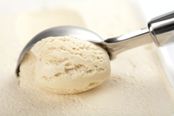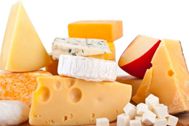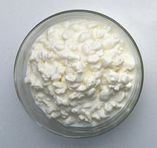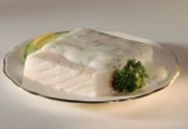Useful ingredients to have in the Fridge/Freezer
Although we were not fans of desserts whether ready-made or home-made, they were useful to supplement Alex’s diet. He often used them as small snacks between meals simply to increase calorie intake when decreasing weight became a problem.
Ice creams and sorbets are useful to have in your freezer to increase the fluid intake of the dysphagic patient. However, be aware that they melt in the mouth and so may be too runny / thin for some patients to swallow safely.

Crème caramel / mousse / milk jelly. Although probably loved by the person with a sweet tooth, nutritionally they are not very worthwhile, as is the case with ice cream, sorbets and chocolate. However, when other forms of nourishment are hard to swallow, these foods can have a place in the dysphagic diet.
Flavoured fromage frais (such as Petits Filous) is almost fat free and has a suitable viscosity for dysphagic patients. It often contains added vitamins.
Stewed fruit and custard / fruit fool are usually the right consistency for the dysphagic patient to eat safely, but remember to stir the fruit into the custard to ensure the viscosity is uniform.
Fruit smoothies are easily made in a blender from fresh fruit you have at home. However, to save time, you may want to buy ready-made ones and store them in the fridge.
Crème fraîche is useful when making hot creamy sauces as it does not curdle, unlike cream or soured cream.
Cheese. Try adding grated cheese into creamed mashed potato for a change – it makes delicious cheesy mash. If you add some finely chopped, fried onion too and sliced grilled tomato, it becomes a meal in itself, although quite high in cholesterol.

Soft cheese (e.g. Philadelphia) was not only handy for wraps and crackers, but also to add creaminess to a sauce.
Dairylea processed cheese provided another useful snack that Alex found easy to swallow safely.
Fresh milk, as already mentioned, is one of our most complete foods. However, if a dysphagic patient can only swallow small quantities of food, it is better to add whole milk rather than semi-skimmed milk and add some dried milk too to stop the food becoming too runny.
Cottage cheese is moist so provides a suitable topping for crackers.

Liver pâté is a good source of protein, vitamin A and iron although it is high in cholesterol.
Greek natural yoghurt is thicker than regular yoghurt as the whey has been strained out so it is often more suitable for a dysphagic patient. It also contains probiotic cultures and twice as much protein as regular yoghurt. However, all yoghurts are good sources of calcium and vitamins. If you are not keen on natural yogurt, try adding honey or puréed fruit or buy ready-made flavoured varieties.
Boil-in-the-bag fish in sauce is a useful standby food in your freezer to go with mashed potato and a vegetable if you haven’t time to make your own sauce and fish. The portions are often small too so you avoid waste.
